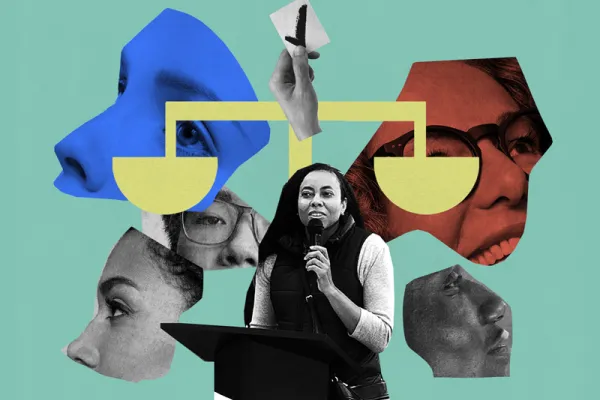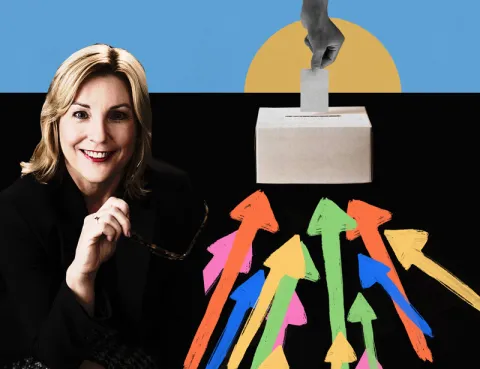Block the Vote
Alumnae News
Voter suppression laws are on the rise. But these Smithies are fighting back, working to expand political participation by eliminating ballot restrictions and empowering disenfranchised voters.

Published July 1, 2022
Among the patchwork of flyers in the Duckett House mailroom, one stood out to Camille Wimbish ’01 during her junior year at Smith. The Gore campaign needed volunteers to travel to New Hampshire, the first primary state, and canvass for then–presidential candidate Al Gore. Intrigued, Wimbish enticed one of her best friends to come along. They spent several weekends in New Hampshire, chatting with potential voters and discovering the dynamics of campaigning. Wimbish wished she could be one of the staffers who would continue traveling with Gore, perhaps to the presidency, and work for a better future. “They’re making such an impact,” she marveled.
Gore, of course, never moved into the Oval Office. But the jolt of energy Wimbish felt in contributing to the greater good stayed with her. She earned a law degree and today serves as election administration director with Ohio Voice in Columbus, where she advocates for policies and laws to improve election administration and access to the ballot. Among other roles, she coordinates the Ohio Fair Courts Alliance, whose goal, according to its website, is to create a court system that “exemplifies and protects equity, fairness, and justice for all.”
Wimbish is among the Smith alums working to protect voting rights at a time when those rights are under threat, with potentially disastrous consequences for democracy. The Brennan Center for Justice, a nonprofit law and policy institute, reports that as of mid-January, 27 states were considering more than 250 laws that would impose restrictions on voting—more than triple the number of similar laws proposed at the same time in 2021.
THERE IS A coordinated effort to destroy confidence in the integrity of our elections.
As the 2022 midterm elections approach, proposed bills have included one that would permit Missouri election officials to discard a mail ballot if the signature “does not appear to be valid.” A New Hampshire bill would let any citizen conduct a “citizen’s audit” of an election, a scenario that could allow partisan operatives to make unsubstantiated claims about the election results. In Arizona, several proposed bills would allow election officials to be charged with a felony for an unintended administrative error. Currently in Texas, the law stipulates that a student can’t use a University of Texas ID as a form of government identification to vote—but can use a handgun license.
“Our democracy is in a three-alarm fire,” Wimbish says. “There is a national coordinated effort to destroy confidence in the integrity of our elections while blocking fair maps and voting access—all to stop the growing political power of Black and brown communities. We need to wake up and grab a firehose before our house burns down. Together we can hold leaders accountable whenever they threaten our freedoms and vote for lawmakers who will make the promise of our democracy real for us all.”
ANTI-VOTER EXTREMISM
People may debate in good faith best practices to ensure fair elections. The problem begins “when people start thinking about voting as a partisan issue versus a right that’s fundamental to how we function as a democracy,” says Katrina Gamble ’99, a former political science professor and now social impact strategist whose company helps groups run advocacy, electoral, and civic engagement campaigns. “Voting rights is not partisan. People should have access to the ballot regardless of their political affiliation, race, or any other kind of marker.”
Controversial voting proposals aren’t the only potential menace to elections. Threats against election officials have skyrocketed. In a March survey, the Brennan Center found that one in six local election officials has received threats. Fewer than half the cases were reported to law enforcement. Poll workers—the majority of whom are 60 or older, according to the Pew Research Center, a nonpartisan think tank—have expressed worries about their safety.

Katrina Gamble ’99 helps groups run advocacy, electoral, and civic engagement campaigns.
The 2016 presidential election between Donald Trump and Hillary Clinton “was a definite dividing line for us for making sure boards of elections had clear safety plans, and talking to the public [to] convince them they’re going to be able to vote and no one should threaten or intimidate them,” Wimbish says.
Some congressional leaders attempted to secure voting rights through national legislation. The Freedom to Vote Act would have expanded automatic and same-day voter registration, voting by mail, and early voting. It also would make Election Day a national holiday, giving more workers the possibility of paid time off to vote. The John R. Lewis Voting Rights Advancement Act would require states with legacies of discrimination to obtain federal approval in advance—known as preclearance—before making any changes to voting in their states. The act would reinstate protections from the 1965 Voting Rights Act (VRA) that were eliminated in 2013 as a result of the U.S. Supreme Court decision in Shelby County v. Holder.
Claire Snyder-Hall ’86, executive director of Common Cause Delaware and author of the memoir Battling the Prince: A Woman Fights for Democracy, organized events in support of both bills. Her organization’s mission, like that of its national parent group, is to protect and strengthen democracy.
“Since the 2020 election, there has been an outpouring of anti-voter extremism all over the country,” she says. “Anti-voter extremists are working in most states to try to pass laws that create barriers to voting, particularly to silence the voices of Black and brown voters, and to give state legislatures the power to overturn democratic elections. We wanted to pass federal legislation which would create a bold set of national standards so that no matter where you live, what state, what ZIP code, what you look like, you have the same freedom to vote.” The U.S. Senate didn’t approve either bill.
TARGETING COMMUNITIES OF COLOR
How did we get here? While some may cite the effect of a more conservative Supreme Court, with three justices appointed by President Trump, the roots of the changes go much deeper.
Consider the history of our relatively young democracy. The United States is often held up as a beacon of democratic ideals. But democracy in the U.S. “was never strong when there were Jim Crow laws. It wasn’t strong during slavery,” says Snyder-Hall, a former political theory professor who believes democratic culture in this country has been and remains weak.

Claire Snyder-Hall ’86 aims to protect and strengthen democracy in her role with the Delaware chapter of Common Cause.
The right to vote was granted to Black men in the 15th Amendment. Yet for more than 100 years, in many states, Black men and later Black women were denied that right through literacy tests and poll taxes. The Voting Rights Act was “a leveling of the playing field,” says Wimbish, who believes the Supreme Court “gutted” the Voting Rights Act with its decision in Holder.
Writing for the majority, Chief Justice John Roberts maintained that preclearance was no longer needed, arguing that voter registration and turnout have risen substantially among disenfranchised groups since 1965. In her dissent, Justice Ruth Bader Ginsburg countered, “Throwing out preclearance when it has worked and is continuing to work to stop discriminatory changes is like throwing away your umbrella in a rainstorm because you are not getting wet.”
Today, voters must prove they are disenfranchised by new maps and voting restrictions, rather than states having to prove changes they want to make aren’t discriminatory. The shift gave states the ability to close voting locations, shorten the time for early voting, and scrap other practices that make voting more accessible.
“These ideas are dangerous, and they’re certainly targeted at the Black and brown communities that have been growing in terms of the number of folks who are turning out to vote,” Wimbish says. “They are designed to silence our communities. Unless and until we pass a fix to the Voting Rights Act and pass the Freedom to Vote Act, we’re going to keep fighting state by state to maintain some level of voting access for all Americans.”
GERRYMANDERING has emboldened state legislatures to curb voting rights.
Snyder-Hall agrees that race figures into why some state legislatures are keen to restrict voting among certain groups. “I think the specter of white, heterosexual men losing their automatic privilege because of demographic and social changes has created a lot of anxiety and anger for some people. [President] Trump was able to run on a platform that articulated those voices and make it safe for people to come out of the shadows and say things they didn’t say openly in the past, racist things.”
Class and educational differences are also critical factors, Snyder-Hall adds. “White people without a college degree are much more likely to support the far-right xenophobic racist agenda, although white people in every [economic] group supported Trump.”
Ultimately, Congress will need to pass national voting standards to prevent wide variations in rules from state to state, Wimbish believes. “We can’t rely on the Supreme Court to save us” on this issue, she says.
NEW BLOWS TO THE VOTING RIGHTS ACT
To enhance the voting power of “their” voters, both Democrats and Republicans have used gerrymandering over the years for political advantage. Gerrymandering can distort what the majority of voters really want. It has also produced state legislatures emboldened to introduce new measures to curb voting. In 2019, the Supreme Court ruled that partisan gerrymandering is outside its jurisdiction, leaving state legislators free to draw districts that favor their party without fear of running afoul of the law.
Later this year, the Supreme Court is expected to consider Merrill v. Milligan, a case based on Section 2 of the Voting Rights Act, which forbids voting practices that discriminate based on race or color. The justices will determine whether Alabama must create a second majority-Black congressional district. Plaintiffs charge that the state’s current map was drawn to pack Black voters into one of seven districts. A lower court required Alabama to redo the map, but the Supreme Court has stopped that order as part of its emergency or “shadow” docket.
The court might conclude new maps are needed. Or it could “take the opportunity to further weaken Section 2,” says Alice Hearst, professor of government at Smith. “One of the compromises in the Constitution was to leave considerable power with the states to create voting standards and draw congressional districts, and I worry that this court will go back to that history to essentially undercut what remaining force the VRA has.” Proponents of the current map believe redrawing it would force Alabama to consider race in district lines, which they say is unconstitutional, according to Hearst.

Professor Alice Hearst worries that the Supreme Court will gut the Voting Rights Act.
As for what else lies ahead, the U.S. Court of Appeals for the 8th Circuit will hear a case in Arkansas that could further curtail the Voting Rights Act by considering who can even bring a lawsuit over it. The American Civil Liberties Union (ACLU) and NAACP sued over a new Arkansas State House map, saying it diminishes the ability of Black voters to elect candidates they prefer. A federal district court judge ruled that only the U.S. attorney general could sue under Section 2 of the Voting Rights Act, rather than private individuals or groups. With that decision, “the court ignored decades of precedent permitting private individuals to vindicate their rights under the VRA,” the ACLU says on its website.
With such powerful legislative and judicial forces at work, average people may feel they have no influence on preserving voting rights. Gamble and others recommend paying attention to your state politics as much as what happens in Congress. If you’re in a state where there’s a movement to push voter suppression laws, look for opportunities to call your state legislators, write a letter to the editor, and speak out, Gamble urges. “State legislators probably get fewer contacts from people who live in their districts than members of Congress. That one phone call or letter probably has a much higher impact.”
Some states are moving to protect or expand voting rights, or at least consider their options. New Jersey, New York, and Nevada have passed legislation to give formerly incarcerated people the right to vote, expanding the electorate as a result. Post-pandemic, some states are reviewing the success of voting by mail; bills in Indiana, Missouri, and Rhode Island propose no-excuse absentee voting. Legislators in five states have introduced bills to automatically register voters.
Though the nation is facing extraordinary pressures on voting rights, Gamble sees reasons for hope, even if current successes are incremental. She takes comfort in the younger people engaged in the democratic process who are becoming leaders on this issue. “When I first started doing this work, well over 10 years ago, when you went into a space and talked about voting rights and democracy, you were usually in a room full of lawyers or policy folks,” she recalls. “It felt very wonky.”
More people have come to understand that preserving voting rights is critical to passing legislation on economic and social justice issues that affect families and communities, Gamble says. “We all in some way have a role to play in protecting and strengthening our democracy.”
How You Can Help
Want to do more to protect voting rights? Four ways to get involved.
- Become a poll worker. Some communities have faced a significant shortage of poll workers on Election Day. Learn how to sign up at the National Association of State Election Directors site, or type “poll workers needed near me” into your favorite search engine.
- Check volunteer opportunities with VoteRiders, which educates and helps voters in each state obtain the identification required to vote. VoteRiders’ goal: Ensure no eligible voter is deprived of the ability to vote due to a lack of correct ID.
- Volunteer for or donate to nonpartisan voting rights projects. As a poll watcher with the Election Protection coalition from the Common Cause Education Fund, you’ll report any election irregularities to the proper authorities and assist voters if they run into problems with voting.
- Support legal action. The League of Women Voters fights voter suppression through advocacy and legal initiatives. The Lawyers’ Committee for Civil Rights Under Law has been active in filing lawsuits, in partnership with local and state organizations, against voting laws that may hinder an equal opportunity to vote.
This story appears in the Summer 2022 issue of the Smith Alumnae Quarterly.
Democracy in Distress
A Special Series

Introduction by Erin Pineda
What is democracy? This seemingly simply question has a seemingly obvious answer: It means, literally and etymologically, that the people rule themselves. But this straightforward reply leads to a tangle of thorny questions: How, exactly, are the people meant to rule themselves? What institutions and procedures enable the people’s rule? Are there limitations on the exercise of popular power—on what the people can elect to do?
PART 1: My Body, But Not My Choice by Andrea Cooper ’83
Navigating a post-Roe world with Candace Gibson ’07 of the National Latina Institute for Reproductive Justice and Genevieve Scott ’06 of the Center for Reproductive Rights.
PART 2: Block the Vote by Andrea Cooper ’83
Voter suppression laws are on the rise. But Smithies are fighting back, working to expand political participation by eliminating ballot restrictions and empowering disenfranchised voters.
PART 3: BANNED by Andrea Cooper ’83
The debate over what constitutes “appropriate” content jeopardizes the open exchange of ideas.
PART 4: When Culture Wars Come for Kids by Oliver Haug ’20
Transgender youth are being attacked by a barrage of new legislation. These Smithies have their backs.
Illustration by Anthony Russo
Camille Wimbish ’01 works to improve election administration and ballot access. Illustrations by Franziska Barczyk